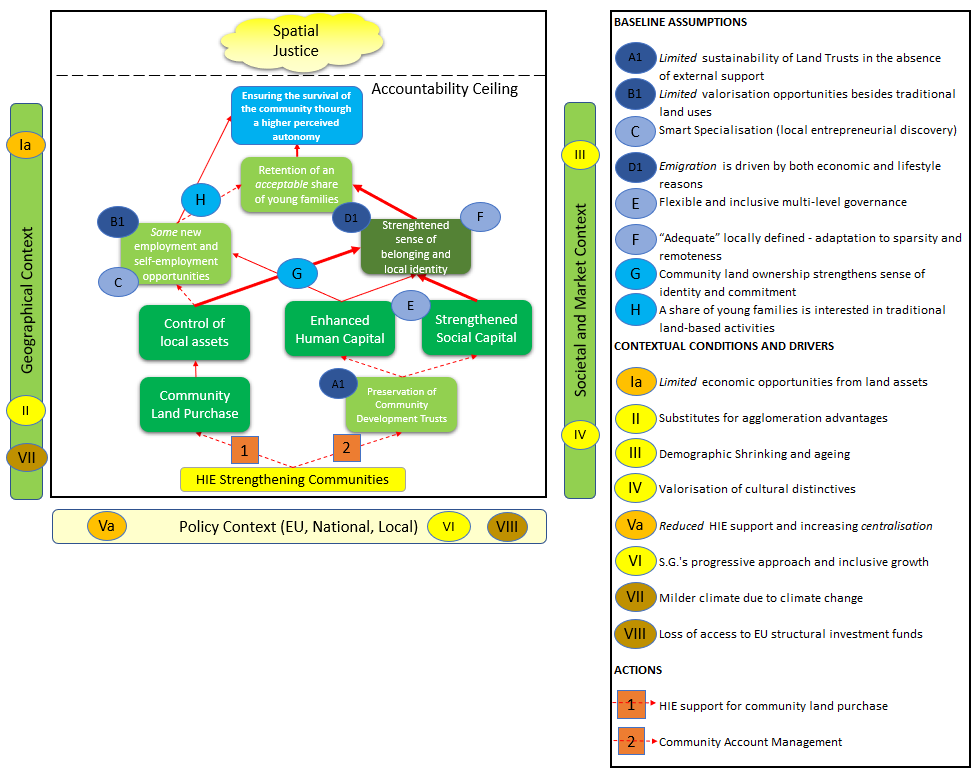Contributed by Simone Piras (The James Hutton Institute). The RELOCAL methodology and the scenario for Lewis have been developed by Andrew Copus, Margaret Currie, Dominic Duckett and Simone Piras (The James Hutton Institute).

The European project H2020 RELOCAL (“Resituating the local in cohesion and territorial development”), of which the James Hutton Institute is a partner, studies the issue of spatial justice across Europe by analysing 33 case studies of place-based interventions. One of these case studies focuses on Strengthening Communities, implemented in the Isle of Lewis by Highlands and Islands Enterprise (HIE).
Besides the Lewis case study, Hutton leads the RELOCAL effort to compare the logic of the interventions and identify how these will contribute to achieving spatial justice in 2030 scenarios for the 33 case study localities. A systematic methodology was developed for this purpose. The intervention logic is illustrated though a so-called “theory of change mechanism map”.
Lewis was selected as a case study because it is an island with a largely dispersed population, far away from large metropolitan areas, and with comparatively low levels of service provision. In the RELOCAL terminology, it is a case of spatial injustice driven by “territorial disadvantage”, which makes it more difficult to achieve the same level of wellbeing as elsewhere. Other types of injustice identified in RELOCAL include “neighbourhood segregation”, more common in urban areas, and “place disempowerment”, typical of areas that have been declining for several reasons. However, in Lewis a large share of the population (72%) lives on community owned land, which is higher than anywhere else in Scotland, making it an interesting point to build upon.
Strengthening Communities consists of two interrelated “actions”: supporting groups of residents (constituted as Community Land Trusts) in the process of community land purchase in the context of the Scottish Government’s land reform; and legally assisting them as they explore and develop opportunities for land-based economic activities (Community Account Management). As such, it aims at achieving a broad equivalence of wellbeing and opportunities for Lewis as can be achieved in more geographically advantaged areas. The first action focuses on distributional justice (fair access to resources), and is expected to trigger additional economic activity and employment and thus demographic sustainability though the innovative exploitation of land. The second, “soft” action focuses on procedural justice by developing community and individual capacity to act within the existing administrative framework. The pathways towards spatial justice activated by the actions rely on a number of assumptions: that the Trusts can identify sustainable revenue streams (which has been problematic for one of them after the end of energy subsidies); that opportunities to generate revenues from local assets exist (e.g. recreation, housing); that enhanced wellbeing leads to demographic sustainability; that the governance framework is responsive to local actors; and that “adequateness” of wellbeing is defined by stakeholders relative to local constraints. However, such assumptions derive from contextual conditions which may change in 2030: the presence of valuable environmental assets, primarily the landscape; a strong relationship with a local customer base as a replacement for economies of scales; cultural uniqueness (Gaelic language and the Free Church); and continuity of HIE support and of the Scottish Government’s inclusive growth approach.
The 2030 scenario was developed by Hutton researchers in consultation with local stakeholders. A trend which stood out is the enduring demographic depletion. This is closely linked to a persisting neo-liberal economic paradigm at global, European, and national level which promotes centralisation and rationalisation, favouring agglomeration, and thus large cities. This will be only partially counterbalanced by the Scottish Government’s progressive response to decline, improved rural digitalisation, and the opportunities generated by a milder climate (e.g. a longer grazing and tourist season). The unique identity and the commitment of local citizens are thus expected to become even more focal points to build upon.
The dynamics identified in the scenario exercise will lead to less favourable contextual conditions: limited opportunities to create value from environmental assets compared to more accessible places; lower institutional responsiveness to local actors; and loss of EU funds. As a result, the Trusts will have difficulties in achieving financial sustainability and triggering economic activity, and the intervention will need to adapt, underpinned by different assumptions. The new, “softer” path towards spatial justice will likely centre on a renewed sense of belonging rather than on economic growth, and the final goal will need to be downscaled. The limited employment and self-employment opportunities will help retain only a share of young people: out-migration of the rest of them will be driven by an aspiration to urban lifestyles which cannot be overturned through job availability alone. In turn, this will result in adaptation to demographic depletion underpinned by a locally-defined sense of “adequateness” and “autonomy”. The future intervention logic is illustrated in the theory of change mechanism map below.

The scenario for Lewis echoes the story of many remote rural areas which must compete with places benefitting from agglomeration effects (i.e. cost savings thanks to closeness of many businesses, services, and people) in the framework of an economic model favouring the latter. Similar patterns of population decline and shrinking financial resources were identified in most rural and sparsely populated places studied in RELOCAL. While place-based interventions are definitely required to improve wellbeing there, these are not enough if spatial justice goals are not decoupled from economic growth and efficiency, particularly in the context of population decline. Strategies of “territorial branding” centred on cultural and environmental uniqueness also suffer from increasing competitiveness, with more accessible places better placed to exploit them. The Coronavirus pandemic, which broke out when the scenario had already been elaborated, has also shown the vulnerability of development models centred on tourism. A different narration of rural life, targeted primarily at (current or potential) young residents, is thus needed.
